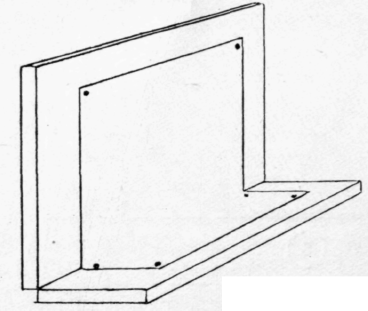Plans and Elevations
Description
This section is from the book "The Manufacture Of Boots And Shoes: Being A Modern Treatise Of All The Processes Of Making And Manufacturing Footgear", by F. Y. Golding. Also available from Amazon: The Manufacture Of Boots And Shoes.
Plans and Elevations
Plans and Elevations of the foot and leg are sometimes taken, and this in the case of orthopoedic work is necessary. It may be taken in several ways, but the simplest plan is to take two hinged boards, as illustrated in Fig. 57, and fasten to the board that is to be used as a base, by means of drawing-pins or tacks, a sheet of paper. The foot is now placed on this portion of the paper and a draft outline taken. Without moving the foot the other board is brought in position as illustrated, and fastened by the hook provided. The paper is pinned to the upright board, and an elevation outline of the foot and leg marked. The positions or locations where the various girth-measures are taken may be marked on the plan and elevation. A little platform may be added to the base, regulated by a screw, so that the height of heel may be imitated and allowed for in the tracings.

Fig 57.
Some variations in the methods described are sometimes made, such as substituting a paper strip in place of the tape-measure for taking the girths, and by a slight transverse tear on one edge, the joint, instep, and heel is registered. The other edge of the paper slip records the ankle and leg measure.
An additional joint and instep measure is also sometimes taken, termed past or second joint, and lower or second instep measurements respectively.
It is a good plan to have printed (or purchase) "be-spoke measurement sheets" that give on one side space for taking plan-drafts, and printed spaces for systematically recording the measurements and peculiarities. On the other side of the sheet should be printed the method of taking the measures, which, if carefully followed, would ensure the measurer and the various hands through which the "measure" may pass adopting the same uniform system.
Continue to:


